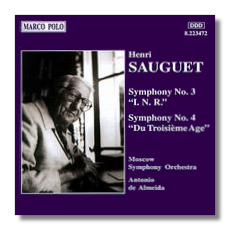
The Internet's Premier Classical Music Source
Related Links
- Latest Reviews
- More Reviews
-
By Composer
-
Collections
DVD & Blu-ray
Books
Concert Reviews
Articles/Interviews
Software
Audio
Search Amazon
Recommended Links
Site News
 CD Review
CD Review
Henri Sauguet

Symphonies
- Symphony #3 "I.N.R."
- Symphony #4 "Du Troisieme Age"
Moscow Symphony Orchestra/Antonio de Almeida
Recorded in Moscow, January 1995
Marco Polo 8.223472 DDD 75:01
Many listeners are afraid that they won't like modern music. They turn to the music of the relatively distant past and let the received wisdom of history help to filter out the banal and trivial, and find quality. But the selection, while it speaks to human nature, often has little or nothing to say about our modern situation.
The only thing left to do is to explore, take risks, and decide for ourselves what is good. We must become pioneers. This means from time to time exposing our ears to noise. Sauguet was not afraid to make noise. Charles Ives would have approved of this music. As Sauguet was essentially self-taught, his art was not spoiled by the abstractions of the academy, and the noise is enjoyable, mostly rough, and energetic.
Sauguet rejected serialism and twelve-tone technique without losing touch with the spirit of the times. He was in close contact with many of the famous exponents of twentieth-century French music - Milhaud, Messiaen, Koechlin - and looked to Satie and Debussy as models. His music is essentially French in spirit, but also very much his own. These symphonies, while very modern in their melodic lines and harmonic structure, are organized in a traditional way, with three movements each and discernible themes, development, and coda. The third symphony includes a fugue, passacaglia, and scherzo. The passacaglia sounds like a dissonant version of Hovhaness, slow, steady, and logical. Try to imagine a Carl Ruggles fugue with a French accent, and you'll get a sense of the faster movements.
The fourth symphony is described by the composer as a summing up, from the perspective of one near the end of life, but it doesn't sound like that at all. There's a lot of forward movement and little resignation. I wish I knew the name of the electronic instrument included in the orchestra for this work, but the liner notes don't say anything about it. (It might be the ondes martenot, though the tones all have a steady pitch.)
The symphonies are well put together, the product of carefcraftsmanship, but there is little in them of a lyrical nature. The themes often seem perfunctory and practical, and I cannot imagine any of them being sung. As a result the music is not especially memorable, although it is interesting to listen to.
With this disc, Almeida completes the cycle of Sauguet's four symphonies, all apparently first recordings. Sauguet's music is enjoying a revival, at least on recordings. Four or five years ago maybe a handful of discs could be found, now it's dozens. But the Melodie Concertante for Cello and Orchestra, with Rostropovich as soloist and the composer conducting, is apparently out of print. That looks interesting on paper, at least.
The sound on Marco Polo is clear and realistic, the dynamic range excellent. The performance is enthusiastic and technically fine.
For those listeners who are willing to explore, the symphonies of Henri Sauguet offer a new and different experience. I found this music interesting and entertaining, and well worth hearing.
Copyright © 1997, Paul Geffen


















